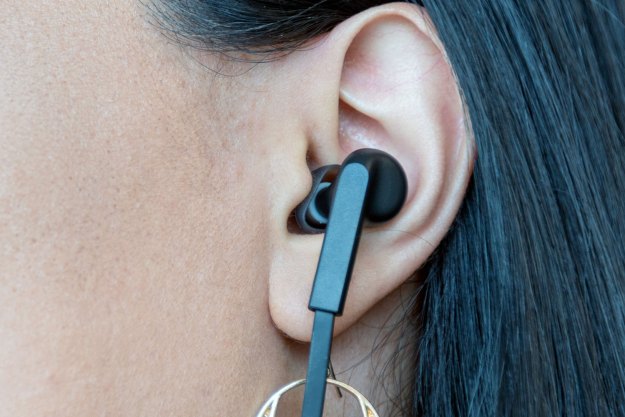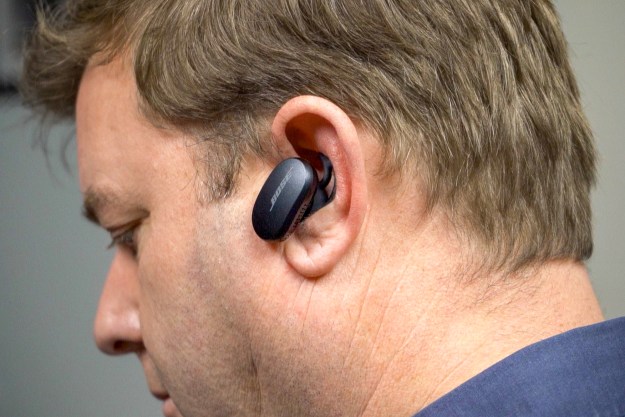
- Outstanding call quality
- Decent music performance
- Convenient magnetic earbuds
- Great battery life
- Good price
- Bass needs more depth
- A little bulky to accommodate bigger battery
Jabra has taken a few serious stabs at Bluetooth earbuds throughout the last 18 months. The Sport Pulse, Sport Coach, and Sport Pace took a decidedly fitness-based approach, while the Halo Fusion moved in a new direction.
Now, there is the Halo Smart, a pair of wireless earbuds that are less about measuring active performance and more about doing phone calls and music properly — and for a longer period per charge. Despite some ups and downs on the music side of the equation, these turn out to be a solid pair of earbuds worth the price of entry.
Out of the box
Inside the box with the Halo Smart are a pair of silicone eartips as options to the set pre-installed on the headphones. A short Micro USB cable is also included for charging.
Features and design
The Halo Smart’s most distinguishing design element is its contoured neckband with wires sticking out on either end for the earbuds. Removable stickers on the band note where magnets are located for attaching the backs of the earbuds, which are also magnetized so they can be snapped to each other. A fairly large battery is crammed inside the band to give the Halo Smart extended operation of up to 15 hours for music and 17 hours of call time, based on Jabra’s estimates.
The right side of the band has playback and volume controls. The middle multifunction button powers the headset on and off, plays and pauses audio, and answers and ends calls. The volume buttons can also skip or go back a track if held for one second. The left side of the band has a microphone button that triggers an active voice assistant, like Siri, Google Now, or Cortana.
Under a back plastic tab is a Micro USB slot covered by a rubber flap. The inner sides that connect to that piece are rippled, called “Flex zones” to make the band more adjustable when putting them on or taking them off. Connecting the two earbuds via the magnets has a functional purpose in that detaching them answers a phone call, while attaching them can end a call automatically.
The Halo Smart isn’t especially heavy, and the earbuds are nicely designed, staying in place well, even with movement. Interestingly, it has dust and water resistance with an IP54 rating, but that’s more to do with sweat than taking the unit for a swim.
The Halo Smart come in simple black color scheme, though there is a silver model sold exclusively at Best Buy.
Setup
Holding the multifunction button for about three seconds powers on the Halo Smart (holding it for five turns it off), which goes immediately into pairing mode upon first startup. We tried them with both an iPhone 6 Plus and HTC 10, and downloaded the free Jabra Assist app (Android | iOS) for both devices.
Message reads new messages out loud so you don’t have to stop to look at your phone
The app facilitates pairing as well, so in the event of pairing issues (which we didn’t), we did have that option. It also has “Find my Jabra” in case the headset is misplaced or missing, plus “Message Readout,” which is a feature that reads new messages out loud so you don’t have to stop to look at your phone. This is off by default, but it’s simple to just slide it on should you want to. For Android, in particular, turning this feature on allows the app to read incoming text messages as they arrive, calendar notifications, and even some social media updates. Since Apple doesn’t open things up the same way, those features aren’t offered on iOS.
The full manual for the Halo Smart is included through the app, which is more detailed than the quick start guide that comes in the box. Looking at it was worth the time spent because we found some features we hadn’t seen before. Pressing one of the volume buttons while not listening to anything, for example, announces battery level. Holding the volume up and multifunction button for three seconds (careful, because five seconds does a factory reset) turns voice guidance on. Holding volume down and the multifunction button for three seconds turns it off. There are also different uses for the multifunction button on handling multiple calls.
Audio performance
While music would be the most logical place to start, the Halo Smart stands out more for how it handles audio for phone calls. This is one of the best wireless headsets we’ve used on the go for talking to people. The combination of a larger microphone and noise cancellation work together to silence ambient noise and enhance voices. We noted this when callers remarked on how clear we sounded, even when there was some background noise. They, in turn, also sounded great.
We liked it so much that we started using the Smart for phone calls while at home. Detaching the earbuds made it easy to answer and end calls, and the fact it announced who was calling was nice, too.
For music, they performed well, but some sacrifices were audible after a while. Where other earbuds struggle mightily to deliver deeper lows to produce good bass, the Halo Smart does a decent job, except for some muffled depth at the very low end. The bass is easy enough to hear — that’s not so much the issue. It’s that there isn’t quite enough resonance for tracks that need it. Playing Sade’s Bulletproof Soul, which is heavy on its bass guitar, sounds nice, but the riff isn’t as impactful as it could be. Same with Stay by Kygo. It sounds good, but it’s too cautious on the register, prompting us to raise the volume to add a little punch.
This is one of the best wireless headsets we’ve used on the go for talking to people.
Despite all that, this isn’t a major drawback for the Halo Smart. Compared to wireless earbuds that are more expensive, including Jabra’s own Sport Pulse and Sport Coach, for instance, these hold up more than well enough to appreciate. Genres that are more balanced on the audio spectrum come through sounding great, and we had no problem going through a playlist of jazz, pop, 80s new wave, and 70s funk wearing the Smart.
Battery life did help too. At higher volumes, we managed to get a good 10-12 hours of music playback. Mixed usage with music and talk time was pretty much the same as well, though the more we talked, the more we were able to listen to music in the long run. Wireless earbuds aren’t generally known for working too long per charge, but the Halo Smart is excellent in that regard. And charging from empty to full takes just over 90 minutes.
Warranty information
Jabra offers a one-year limited warranty upon proof of purchase, and is only applicable in the country or territory where it was purchased. Exempted from the warranty are the consumables that come with it, like the eartips and micro-USB cable.
Conclusion
At $80, the Halo Smart are priced well enough, but our endorsement could have been earned even at a higher price thanks for their excellent execution of their dual functions. For pure music listening, there are better options if you’re extremely picky, but when you fold in excellent battery life and excellent call quality with that perfectly acceptable audio, you have a winner in our book. At the end of the day, it’s hard to beat the Halo Smart. The Phiaton BT 100 NC are a strong competitor in the same price range, plus they offer active noise canceling. However, you won’t get the same battery life or smartphone integration features that you’ll get with the Halo Smart. All told, it’s easy to give the Halo Smart our Recommended Product badge.
Editors' Recommendations
- Jabra’s latest wireless earbuds have Dolby spatial audio
- Jabra’s $100 Elite 4 are its most affordable ANC earbuds yet
- Jabra’s Enhance Plus hearing aid earbuds are $799
- Jabra’s most affordable workout earbuds debut at CES 2022
- Jabra Elite 7 Pro vs. Apple AirPods Pro: Which Pro wins?










